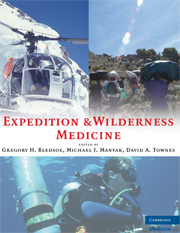Book contents
- Frontmatter
- Contents
- Contributors
- Foreword
- Preface
- Acknowledgments
- PART I EXPEDITION PLANNING
- 1 The Expedition Physician
- 2 Assessing Expedition Medical Needs
- 3 Expedition Medical Kit
- 4 Immunizations
- 5 Legal Considerations during Expedition Planning
- 6 Travel Safety
- 7 Nutritional Support for Expeditions
- 8 Water Treatment
- 9 Special Considerations
- 10 Communications Planning for the Expedition Medical Officer
- 11 Minimizing Risk on an Expedition
- 12 The Expedition Returns
- PART II EXPEDITIONS IN UNIQUE ENVIRONMENTS
- PART III ILLNESS AND INJURIES ON EXPEDITIONS
- APPENDIX The Expedition Medical Kit
- Index
10 - Communications Planning for the Expedition Medical Officer
from PART I - EXPEDITION PLANNING
Published online by Cambridge University Press: 05 March 2013
- Frontmatter
- Contents
- Contributors
- Foreword
- Preface
- Acknowledgments
- PART I EXPEDITION PLANNING
- 1 The Expedition Physician
- 2 Assessing Expedition Medical Needs
- 3 Expedition Medical Kit
- 4 Immunizations
- 5 Legal Considerations during Expedition Planning
- 6 Travel Safety
- 7 Nutritional Support for Expeditions
- 8 Water Treatment
- 9 Special Considerations
- 10 Communications Planning for the Expedition Medical Officer
- 11 Minimizing Risk on an Expedition
- 12 The Expedition Returns
- PART II EXPEDITIONS IN UNIQUE ENVIRONMENTS
- PART III ILLNESS AND INJURIES ON EXPEDITIONS
- APPENDIX The Expedition Medical Kit
- Index
Summary
The planet earth is a sphere with a surface area of 509,600,000 square kilometers. With vast amounts of the earth's surface remote from population centers and city services, there is plenty of room for expeditions to roam. Exploring is all about discovering new things off the beaten track. When a medical emergency arises, however, the very remoteness that makes exploring so interesting can also make it dangerous or sometimes even deadly.
In days past, expedition organizers had few alternatives for mitigating medical risk. Expedition participants were chosen for their exceptional physical fitness, and usually an expedition doctor or medic with experience in expedition medicine was included, but in the end the team prayed for a little luck. There was an expectation and acceptance that exploring was an inherently dangerous undertaking that might result in serious disability or even death.
Things have changed in the twenty-first century. With advancements in medicine and telecommunications have come elevated expectations among those who wish to explore. We read almost every month about someone with a serious disease or disability taking on a challenge that daunted even the most robust individuals in decades past – amputees are summiting Everest, the blind take trips into the Amazon, and septuagenarian retirees cruise to the Antarctic on icebreakers. Extreme sports literally take athletes to new heights. If one of these modern-day explorers is hurt or falls ill, there is an expectation that a communication system will be in place to enable the delivery of medical care to that patient.
- Type
- Chapter
- Information
- Expedition and Wilderness Medicine , pp. 134 - 143Publisher: Cambridge University PressPrint publication year: 2008



